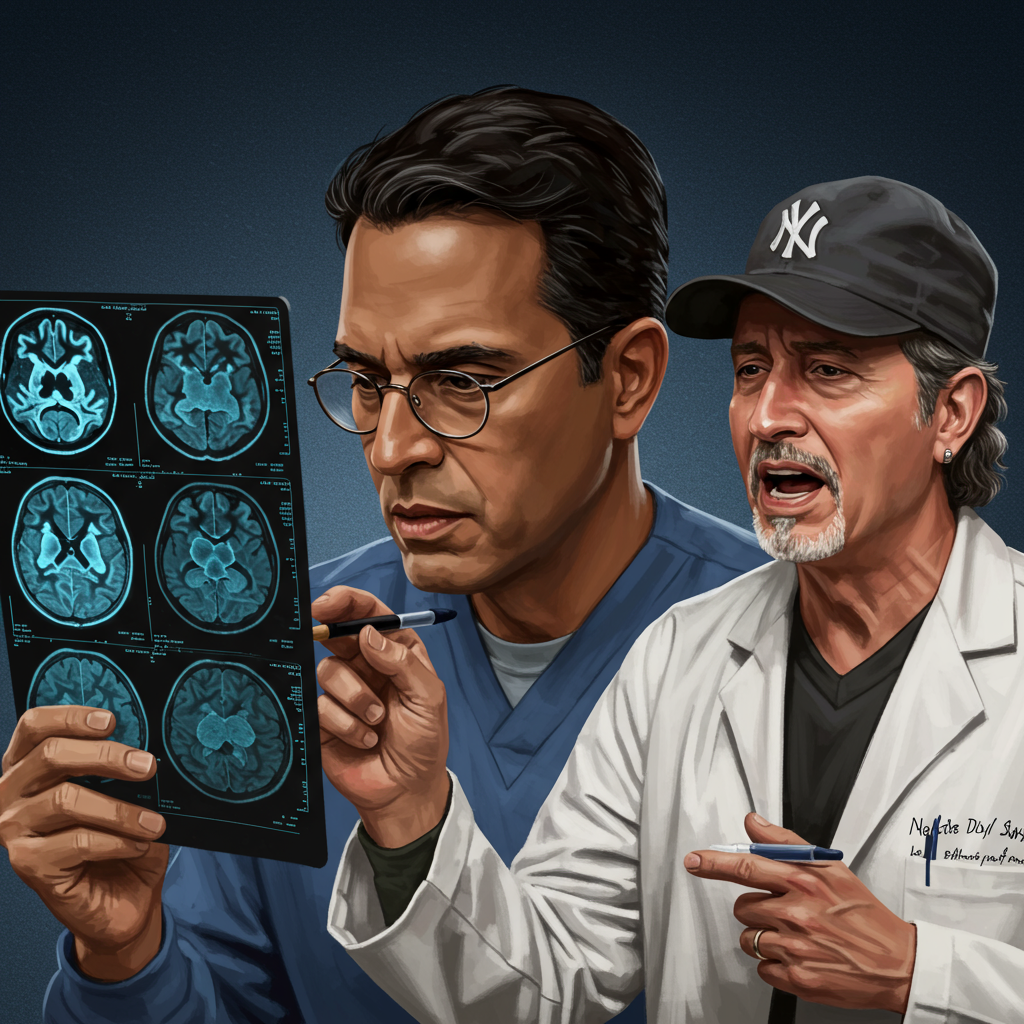Chronic pain impacts a staggering 20% of Americans, trapping millions in a relentless cycle of suffering that often defies conventional medical explanation. Imagine a pain so profound it feels like “lightning bolt razor snakes” or a severe burn multiplied twentyfold, unyielding 24/7. This agonizing reality, vividly described by musician Ed Mowery, sits at the heart of Dr. Sanjay Gupta’s groundbreaking exploration into the mysteries of chronic pain. A renowned neurosurgeon and author, Gupta challenges long-held beliefs, revealing the brain’s surprising and powerful role in how we perceive — and can potentially overcome — even the most debilitating forms of pain.
Understanding the Unseen Agony: Ed Mowery’s Decades of CRPS
For heavy metal frontman Ed Mowery, pain was a constant, unwelcome bandmate. He endured unfathomable torment for decades, a condition diagnosed as Complex Regional Pain Syndrome, or CRPS. This rare and devastating neurological disorder affects hundreds of thousands in the U.S. Mowery’s description of his pain is visceral: “lightning bolt razor snakes in my legs and nerve pain in my arms.” He likened it to “a really bad burn… multiply it by, say, 20 to 30, and then apply it from the neck down.” What made his suffering even more isolating was the doctors’ inability to find a clear physical cause. There was “nothing to point to and says, ‘This is why it’s hurting.'” This fundamental disconnect between excruciating pain and lack of visible injury highlights the profound mystery at the core of many chronic conditions.
The Personal Toll: Gupta’s Family and His Own Pain Revelations
Dr. Gupta’s quest to understand pain is not purely academic. It’s deeply personal. He recounts his 83-year-old mother, Damyanti Gupta, experiencing unimaginable pain after a fall resulted in a compressed lumbar vertebra due to osteoporosis. While imaging showed the injury, the pain itself remained invisible on scans. Damyanti described her pain as “100” on a scale of one to ten, leading her to express a desperate wish “not to live anymore.” This heartbreaking sentiment from his usually stoic mother underscored the overwhelming impact of her chronic pain. Fortunately, successful spinal surgery brought her pain down dramatically, from 100 to about 3.
Gupta also recalls a childhood incident that first sparked his curiosity about pain. As a boy, he attempted to vault over a spiked fence but ended up impaled. Surprisingly, after the initial shock, the intense pain began to recede, coming in waves and even prompting him to check if the spike was “still there, right?” This counterintuitive experience — severe injury with diminishing pain — became a foundational puzzle.
The Brain’s Amazing Pharmacy: Endorphins Explained
Years later, Dr. Gupta understood this phenomenon. His body’s “endogenous opioid system” had activated, flooding his system with powerful natural pain relievers. These “endorphins,” a portmanteau of “endogenous” (from within) and “morphine,” are the body’s own natural painkillers. They not only reduce physical hurt but also improve mood and decrease the memory of the painful event. This revelation about the body’s internal pharmacy was a crucial step in his evolving understanding of pain’s true source.
Shifting Paradigms: The Brain at the Heart of Pain
Gupta’s core argument, detailed in his book “It Doesn’t Have to Hurt,” asserts that the ultimate source of every pain sensation, from a paper cut to CRPS, is the brain. It’s a challenging concept to grasp, especially when pain feels so acutely physical. He likens Mowery’s experience to “phantom pain,” where individuals who have lost a limb still feel excruciating pain from that absent limb. This vividly illustrates the brain’s capacity to create and sustain pain even when the physical source is gone or never existed in the first place. The brain, in essence, “memorizes” pain, sometimes getting it “a little bit wrong” and entering a hyper-drive response. This fundamental shift in understanding pain as a brain phenomenon is revolutionizing how we approach its treatment.
Reverse Translational Research: From Patient to Lab
A significant paradigm shift in pain research is “reverse translational research.” This innovative approach turns the traditional “bench-to-bedside” model on its head. Instead of starting with lab discoveries, it begins with the patient’s real-life chronic pain experience. Researchers then work backward, using advanced tools like brain imaging and blood tests to identify objective biomarkers — measurable indicators — that correlate with subjective pain. This “bedside to the bench” method allows scientists to delve into basic mechanisms with patient-derived insights, ultimately aiming for targeted pain management solutions. It underscores the renewed importance of healthcare providers genuinely “listening to the patient,” making them active partners in their own treatment journey.
Breakthrough at UCSF: Mapping and Interrupting Pain
Ed Mowery’s decades-long struggle led him to a groundbreaking clinical trial at the University of California at San Francisco (UCSF). His pain was so severe, he eventually set aside his initial hesitation about undergoing three rounds of brain surgery. “I was in so much pain, I just didn’t care anymore,” he admitted. Researchers, including pioneering pain physician and neuroscientist Prasad Shirvalkar, implanted electrodes into Mowery’s brain. This allowed them to “listen” to his neural activity and identify specific brain areas and signals linked to his chronic pain.
Over weeks of monitoring, the UCSF team made an extraordinary discovery. Not only could they predict when Mowery was about to experience pain, but they could also quantify its likely severity. Even more astonishing, they found they could interrupt the pain cycle. By delivering a tiny electrical stimulation through the implanted electrodes, they could prevent the pain from even reaching conscious awareness. This ability to predict, measure, and then rapidly inhibit pain represents a profound leap forward in pain management.
The “Unicorn” of Pain Science: Objective Biomarkers
Shirvalkar’s work at UCSF has been instrumental in the quest for objective biomarkers of pain, a challenge often called the “unicorn in pain science.” In groundbreaking clinical trials in 2023, his team achieved a historical first: directly mapping the neural signals of chronic pain. They created unique neural signatures for each participant’s subjective pain experience. A more recent ongoing trial utilizes these neural maps and deep brain stimulation (DBS) to predict an impending “pain burst.” Upon prediction, a precisely calibrated electrical impulse is delivered to interrupt and potentially eliminate the pain. This ability to objectively measure and then rapidly treat pain is an “ultimate achievement” in the field.
Life Transformed: Ed Mowery’s New Hope
Today, Ed Mowery’s life is vastly different. A computer now recognizes his pain coming on and can effectively “shut it off.” He described the moment the signal started working: “I was beside myself.” He’s back to playing music and eagerly looking forward to international tours with his band, Tiwanaku. It took time for Mowery to fully accept that his very real, yet physically untraceable, agony was a “brain disease,” acknowledging, “It was all in my head. But it wasn’t imaginary. It was real.” His journey is a testament to resilience and the power of innovative medicine. Mowery credits his unwavering hope and positive attitude for helping him persevere through decades of suffering.
Future Frontiers: A Glimmer of Hope for Millions
While the deep brain stimulation technology Mowery received is not yet widely available for general use, its implications are monumental. Dr. Gupta emphasizes that this breakthrough provides irrefutable evidence: pain circuitry in the brain is both measurable and malleable. This fundamental insight suggests that chronic pain is a condition that can be targeted and effectively treated. It offers tremendous optimism that a range of non-surgical approaches, leveraging similar principles, will emerge in the future, providing relief for countless individuals suffering from various forms of chronic pain. The journey to a pain-free life, once a distant dream, is becoming an increasingly tangible reality thanks to these pioneering efforts.
Frequently Asked Questions
How does the brain cause chronic pain like CRPS, even without a physical injury?
The brain plays a central and often surprising role in chronic pain. Conditions like Complex Regional Pain Syndrome (CRPS), as highlighted by Ed Mowery’s story, demonstrate the brain’s ability to “memorize” pain experiences. After an initial injury, the brain can misinterpret or amplify signals, creating a hyper-drive pain response even after the physical injury has healed. This is similar to “phantom pain,” where individuals feel pain in a limb that is no longer there. The brain effectively creates and sustains the pain, making it a “brain disease” where signals are generated or amplified internally rather than solely reflecting external physical damage.
What groundbreaking research is Dr. Sanjay Gupta highlighting for chronic pain treatment?
Dr. Sanjay Gupta emphasizes research, particularly from UCSF, focusing on deep brain stimulation (DBS) and “reverse translational research.” Pioneering work by scientists like Prasad Shirvalkar involves implanting electrodes into the brain to map and understand individual neural signatures of chronic pain. This allows researchers to identify objective biomarkers of pain, predict when a “pain burst” is imminent, and even interrupt the pain cycle by delivering targeted electrical impulses. This innovative approach aims to fundamentally change how chronic pain is diagnosed and treated, moving towards more objective and precise interventions.
What does the latest research on brain-based pain treatment mean for individuals suffering from chronic pain?
The latest research, though still in experimental stages like the UCSF deep brain stimulation trial, offers profound hope. It unequivocally proves that the brain’s pain circuitry is both measurable and malleable. While DBS is not widely accessible, this fundamental understanding opens doors for future treatments that could target these brain mechanisms. It suggests that chronic pain is treatable, fostering optimism for the development of new, less invasive, non-surgical approaches that leverage these insights to predict, prevent, and alleviate various forms of chronic pain for millions of sufferers.
Conclusion
The exploration into chronic pain, spearheaded by Dr. Sanjay Gupta and groundbreaking researchers like Prasad Shirvalkar, is fundamentally redefining our understanding of suffering. By shifting the focus from purely physical injury to the complex mechanisms within the brain, we gain powerful new insights and a renewed sense of hope. The harrowing experiences of individuals like Ed Mowery, once seen as inexplicable, are now paving the way for revolutionary treatments. While the journey to widespread pain relief is ongoing, the ability to map, predict, and even interrupt pain signals within the brain marks a pivotal moment. It promises a future where the relentless grip of chronic pain can be loosened, allowing millions to reclaim their lives.




